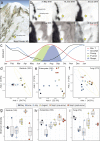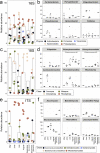Summer Dynamics of Microbial Diversity on a Mountain Glacier
- PMID: 36342146
- PMCID: PMC9769511
- DOI: 10.1128/msphere.00503-22
Summer Dynamics of Microbial Diversity on a Mountain Glacier
Abstract
Glaciers are rapidly receding under climate change. A melting cryosphere will dramatically alter global sea levels, carbon cycling, and water resource availability. Glaciers host rich biotic communities that are dominated by microbial diversity, and this biodiversity can impact surface albedo, thereby driving a feedback loop between biodiversity and cryosphere melt. However, the microbial diversity of glacier ecosystems remains largely unknown outside of major ice sheets, particularly from a temporal perspective. Here, we characterized temporal dynamics of bacteria, eukaryotes, and algae on the Paradise Glacier, Mount Rainier, USA, over nine time points spanning the summer melt season. During our study, the glacier surface steadily darkened as seasonal snow melted and darkening agents accumulated until new snow fell in late September. From a community-wide perspective, the bacterial community remained generally constant while eukaryotes and algae exhibited temporal progression and community turnover. Patterns of individual taxonomic groups, however, were highly stochastic. We found little support for our a priori prediction that autotroph abundance would peak before heterotrophs. Notably, two different trends in snow algae emerged-an abundant early- and late-season operational taxonomic unit (OTU) with a different midsummer OTU that peaked in August. Overall, our results highlight the need for temporal sampling to clarify microbial diversity on glaciers and that caution should be exercised when interpreting results from single or few time points. IMPORTANCE Microbial diversity on mountain glaciers is an underexplored component of global biodiversity. Microbial presence and activity can also reduce the surface albedo or reflectiveness of glaciers, causing them to absorb more solar radiation and melt faster, which in turn drives more microbial activity. To date, most explorations of microbial diversity in the mountain cryosphere have only included single time points or focused on one microbial community (e.g., bacteria). Here, we performed temporal sampling over a summer melt season for the full microbial community, including bacteria, eukaryotes, and fungi, on the Paradise Glacier, Washington, USA. Over the summer, the bacterial community remained generally constant, whereas eukaryote and algal communities temporally changed through the melt season. Individual taxonomic groups, however, exhibited considerable stochasticity. Overall, our results highlight the need for temporal sampling on glaciers and that caution should be exercised when interpreting results from single or few time points.
Keywords: alpine; alpine glacier; biological albedo reduction; cryosphere; glacier biology; snow algae.
Conflict of interest statement
The authors declare no conflict of interest.
Figures


Comment in
-
Addition of dissolved inorganic carbon stimulates snow algae primary productivity on glacially eroded carbonate bedrock in the Medicine Bow Mountains, WY, USA.FEMS Microbiol Ecol. 2023 Jun 16;99(7):fiad056. doi: 10.1093/femsec/fiad056. FEMS Microbiol Ecol. 2023. PMID: 37222475 Free PMC article.
References
-
- Hotaling S, Lutz S, Dial RJ, Anesio AM, Benning LG, Fountain AG, Kelley JL, McCutcheon J, Skiles SM, Takeuchi N, Hamilton TL. 2021. Biological albedo reduction on ice sheets, glaciers, and snowfields. Earth-Science Rev 220:103728. doi:10.1016/j.earscirev.2021.103728. - DOI
-
- Stibal M, Bradley JA, Edwards A, Hotaling S, Zawierucha K, Rosvold J, Lutz S, Cameron KA, Mikucki JA, Kohler TJ, Šabacká M, Anesio AM. 2020. Glacial ecosystems are essential to understanding biodiversity responses to glacier retreat. Nat Ecol Evol 4:686–687. doi:10.1038/s41559-020-1163-0. - DOI - PubMed
-
- Edwards A, Pachebat JA, Swain M, Hegarty M, Hodson AJ, Irvine-Fynn TDL, Rassner SME, Sattler B. 2013. A metagenomic snapshot of taxonomic and functional diversity in an alpine glacier cryoconite ecosystem. Environ Res Lett 8:e035003. doi:10.1088/1748-9326/8/3/035003. - DOI
-
- Dial RJ, Becker M, Hope AG, Dial CR, Thomas J, Slobodenko KA, Golden TS, Shain DH. 2016. The role of temperature in the distribution of the glacier ice worm, Mesenchytraeus solifugus (Annelida: Oligochaeta: Enchytraeidae). Arctic, Antarctic, and Alpine Res 48:199–211. doi:10.1657/AAAR0015-042. - DOI
Publication types
MeSH terms
LinkOut - more resources
Full Text Sources
